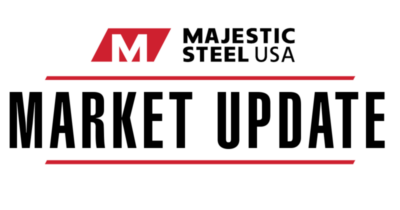Market Update | June 1, 2022
TOTAL CONSTRUCTION SPENDING HITS ALL-TIME HIGH
Coming in at a $1.745 trillion rate in April, total construction spending hit a fresh all-time high. Residential projects are driving total spending as it continues to climb, now accounting for 51.6%, it’s highest percentage since mid-2006.
Input Costs
After sliding last week, zinc pricing rebounded some this week.
-
-
Zinc pricing is currently at $1.70/lb, a still elevated level however.
-
Spot iron ore pricing increased slightly this week, climbing to $136.50/mt.
-
-
Spot iron ore pricing is still down 4.5% m/m and 34.7% below prior year levels.
-
Spot iron ore pricing remains near its lowest level since late January as demand concerns continue as China’s strict COVID lockdowns are affecting both production and demand.
-
Pacific basin met coal pricing was lower last week, sliding to $442/mt.
-
-
Pricing is down 12.3% from this time last week but up 186% from this time last year.
-
Weekly U.S. import pig iron pricing slipped again this week, slipping to $810/mt, down from $867/mt last week and a recent peak of $1,030/mt in late March.
-
-
Cheaper imports from India and the first cargo booked from Ukraine, since the Russian invasion started, helped to push pricing lower of late.
-
Despite the recent decline, the premium of pig iron pricing to domestic prime scrap pricing remains extremely elevated, compared to the 10-year average.
-
June scrap pricing is expected to slide further, however at a much slower rate than in May.
-
-
Early indications point to prime scrap sliding an additional $15/gt-$20/gt in June.
-
Supply
Domestic raw steel production increased slightly last week, climbing for the fourth consecutive week.
-
- U.S. steelmakers produced 1.798 million tons at an 82.4% utilization rate.
- Despite the recent rebound, YTD production is now down 1.5% compared to the same timeframe last year.
Based on preliminary May import licenses, the daily average is down 6.4% compared to the daily pace in April.
-
-
Excluding the volatile Brazilian slab, imports were down 1.2% compared to April.
-
.
DEMAND
After showing the slowest growth in nearly two years in April, manufacturing activity in the Chicagoland area grew sharply in May.
-
-
The Chicago PMI came in at 60.3, up from 56.4 in April but was still below year ago levels (75.2).
-
The inventory component was a big boost to the overall index in May, as the inventory component climbed to a near 50-year high of 69.1.
-
The production component saw the largest increase in May, climbing 10 points.
-
The new orders component saw the second largest increase in May, climbing 8.6.
-
Both the production and new order components are back near their respective 12-month averages after dipping sharply below that level recently.
-
According to survey respondents, when asked about the three greatest challenges to conducting business, the top three answers were increased costs, delivery lead times, and material shortages.
-
Economic activity in the manufacturing sector grew at a faster rate in May.
-
-
The ISM National Manufacturing Index came in at 56.1, up from 55.4 in April and is now in growth territory for the twenty-fourth consecutive month.
-
Any reading over 50 indicates growth, while any reading below 50 denotes a contraction
-
The inventory component represented the largest growth in May, climbing 4.3 points to 55.9.
-
The new order component increased as well, climbing 1.6 points to 55.1.
-
The backlog of orders increased as well, climbing to 58.7 from 56.0 previously.
-
Total construction spending continued to climb in April, hitting a fresh all-time high.
-
-
Construction spending came in at a $1.745 trillion rate in April, up 0.2% from March and up 12.3% from a $1.554 trillion rate in April 2021.
-
Total spending has now increased, on a year-over-year basis, for thirty-five consecutive months.
-
Spending on residential construction projects continued to climb, increasing 0.9% from March to a $900.4 billion rate.
-
Spending on non-residential projects declined, sliding for the second consecutive month.
-
Non-residential project spending slipped 0.4% to a $844.3 billion rate.
-
Residential construction spending now accounts for 51.6% of total spending, its highest percentage since mid-2006.
-
ECONOMIC
After a slight uptick in April, consumer confidence slipped slightly in May.
-
-
The Conference Board’s Consumer Confidence Index came in at 106.4, down from 108.6 in April.
-
The present situation component declined to 149.6, down from 152.9 last month.
-
Despite the slip in May, the present situation remains at a strong level and suggest growth did not decline further in Q2.
-
The expectations component declined as well, sliding to 77.5.
-
This is down from 79.0 in April and shows that consumers are more uncertain around the short-term outlook for income, business, and, labor.
-
This material, information and analyses (the “Content”) may include certain statements, estimates and projections prepared with respect to, among other things, historical data and anticipated performance. Content may reflect various assumptions by Majestic Steel USA, Inc. concerning anticipated results that are inherently subject to significant economic, competitive and other uncertainties and contingencies and have been included for illustrative purposes. Content is provided AS-IS.

